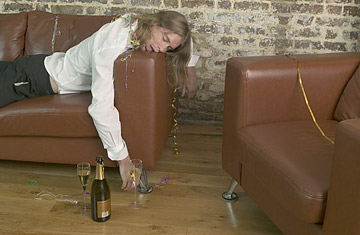
Whatever your reasons — celebration, loneliness, attempting to figure out what “Auld Lang Syne” actually means — if you drank too much on Dec. 31, you probably rang in the new year with a pounding headache and regular trips to the bathroom. If so, don’t worry; you’re not the first person to endure a hangover, and although it feels like it, you won’t be the last.
The oldest hangover remedy is to simply keep drinking. The “hair of the dog” method of self-medication has been around since alcohol was invented, although the canine-related term is actually British (it refers to an old folk remedy for a rabid dog bite). Dean Martin recommended it. So did Ernest Hemingway — but then again, he had issues.
When the ancient Assyrians felt the painful aftereffects of excess merriment, they consumed a mixture of ground birds’ beaks and myrrh. European doctors in the Middle Ages recommended raw eel and bitter almonds. Mongolians ate pickled sheep’s eyes, while China went with a more palatable dose of green tea. Germans still eat Katerfruhstuck, a postbinge breakfast that usually consists of herring, pickles and goulash. Russians don’t eat anything at all; they jump in a sauna and sweat it all out, sometimes flagellating themselves with birch branches to aid blood flow.
In 1845, Italian Bernardino Branca developed a cure-all he called Fernet — an 80-proof concoction containing myrrh (what’s with all the myrrh?), rhubarb, chamomile, aloe, cardamom, peppermint oil and a number of other ingredients including a lot of grape-infused spirits and some opiates. Branca used the drink to treat a number of ailments, including hangovers and cholera. Fernet is still available (now opiate-free), although it’s usually served as an after dinner drink.
P.G. Wodehouse assigned a hangover cure to his most famous fictional creation, Jeeves, the estimable butler famous for his bracer of Worcestershire sauce, raw egg, and pepper. “Gentlemen have told me they find it extremely invigorating after a late evening,” he explained to a red-eyed Bertie Wooster in the 1916 short story, Jeeves Takes Charge.
Jeeves’ restorative isn’t too far from an American concoction called the Prairie Oyster, a mixture of tomato juice, vinegar, Worcestershire sauce, pepper and a raw egg — to give it that extrableeegh. While adherents swear by the concoction, there is no scientific reason why something so disgusting would make anyone feel better.
In 1972, the openly alcoholic Kingsley Amis published the book On Drink, which included several self-researched hangover cures such as beef paste and vodka, baking soda and vodka and several other mixtures involving vodka. Amis also mused on what he called the “metaphysical hangover,” in which physical ailments are replaced with nagging feelings of regret and self-loathing. Unfortunately the only cure for the metaphysical hangover is a lot of self-pity and maybe an album by the Cure.
In the last decade, people have attempted to outsmart alcohol with so-called anti-hangover pills such as Chaser and Alcohol-X, which, when taken before a drink, supposedly help the liver by absorbing toxins. In 1997, a South Korean businessman developed Dawn 808 (Dawn stands for Drinkers Are Winners Now), a canned tea-based drink made from alder leaves that claims to accelerate alcohol breakdown.
Whatever your medicine of choice, you should realize that it’s probably not going to work. Hangovers exist for a reason — your mouth is dry because you’re dehydrated. Your eyes are red because you probably didn’t sleep very well, and your body is sore because you just drank something that is basically poisonous. No amount of Worcestershire sauce, egg yolk or myrrh can change the fact that five hours ago, you were downing lemon drops and dancing on top of a bar to music by KC and the Sunshine Band. So take a shower, have something to eat, and try not to do it again. Well, until next year.
More Must-Reads from TIME
- Why Biden Dropped Out
- Ukraine’s Plan to Survive Trump
- The Rise of a New Kind of Parenting Guru
- The Chaos and Commotion of the RNC in Photos
- Why We All Have a Stake in Twisters’ Success
- 8 Eating Habits That Actually Improve Your Sleep
- Welcome to the Noah Lyles Olympics
- Get Our Paris Olympics Newsletter in Your Inbox
Contact us at letters@time.com